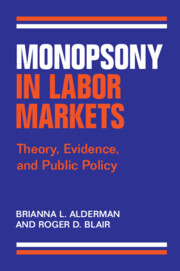Book contents
- Monopsony in Labor Markets
- Monopsony in Labor Markets
- Copyright page
- Dedication
- Contents
- Figures
- Tables
- Preface
- Acknowledgments
- 1 Monopsony in the Labor Market
- 2 The Economics of Monopsony
- 3 Empirical Evidence of Monopsony in Labor Markets
- 4 Antitrust Policy in the United States
- 5 The Intended and Unintended Victims of Monopsony
- 6 Collusion on Wages and Terms of Employment
- 7 No-Poaching Agreements
- 8 Noncompete Agreements
- 9 Unions and Collective Bargaining
- 10 Monopsony and Merger Policy
- 11 Closing Thoughts
- Index
9 - Unions and Collective Bargaining
Published online by Cambridge University Press: 08 February 2024
- Monopsony in Labor Markets
- Monopsony in Labor Markets
- Copyright page
- Dedication
- Contents
- Figures
- Tables
- Preface
- Acknowledgments
- 1 Monopsony in the Labor Market
- 2 The Economics of Monopsony
- 3 Empirical Evidence of Monopsony in Labor Markets
- 4 Antitrust Policy in the United States
- 5 The Intended and Unintended Victims of Monopsony
- 6 Collusion on Wages and Terms of Employment
- 7 No-Poaching Agreements
- 8 Noncompete Agreements
- 9 Unions and Collective Bargaining
- 10 Monopsony and Merger Policy
- 11 Closing Thoughts
- Index
Summary
In this chapter, we turn our attention to labor unions and their role in providing countervailing power. Congress recognized the consequences of individual employees having to negotiate with large employers. For the most part, individual employees have no bargaining power and face all-or-nothing offers that reflect monopsony power. Consequently, Congress passed legislation that would permit employees to unionize and thereby create a labor monopoly. The idea was to level the playing field so workers could not be abused. This chapter provides a brief review of the statutes and the scope of the labor exemption.
The formation of a union converts a monopsony into a bilateral monopoly. The economic effects of a bilateral monopoly are generally positive. Employment and output expand. Thus, both employees and consumers are better off. We explain this analysis and illustrate it with reference to professional sports. This chapter also explores the antitrust conundrum arising from bilateral monopoly.
- Type
- Chapter
- Information
- Monopsony in Labor MarketsTheory, Evidence, and Public Policy, pp. 141 - 159Publisher: Cambridge University PressPrint publication year: 2024



